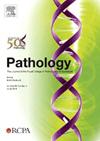Optimising the detection of Trichophyton indotineae and its prevalence in a large Australian laboratory
IF 3
3区 医学
Q1 PATHOLOGY
引用次数: 0
Abstract
The aim of this study was to estimate the prevalence of Trichophyton indotineae, an emerging drug-resistant fungus, in specimens submitted for dermatophyte examination at a large laboratory in Melbourne, Australia, from January to June 2024, and to examine approaches for best laboratory practice for detection of this species. T. indotineae has not been previously isolated at our laboratory. We examined all skin and hair specimens (nail specimens were excluded) for dermatophyte presence by microscopy and culture; species identification was performed by routine phenotypic methods. Trichophyton interdigitale, Trichophyton mentagrophytes and Trichophyton isolates identified to genus level only, which were urease-negative or urease-indeterminate after 7 days, underwent internal transcribed spacer (ITS) region sequencing for definitive identification. A total of 202 Trichophyton isolates from 202 specimens (196 patients) were studied. The most common site of infection was the foot (tinea pedis, 39.3%) followed by, collectively, sites not specified (27.6%) and the groin (tinea cruris, 13.8%). Final identification revealed Trichophyton rubrum (n=128, 63.4%) as the most frequent species, followed by T. interdigitale (n=38, 18.8%) and T. indotineae (n=13, 6.4%). All T. indotineae isolates were initially phenotypically identified as T. interdigitale (n=7) or as Trichophyton species (n=6). T. indotineae caused tinea corporis (n=4, 30.8%), tinea cruris (n=3, 23.1%), tinea manuum (n=2, 15.4%), tinea pedis (n=1, 7.7%), tinea capitis (n=1, 7.7%) and tinea in an unspecified site (n=2, 15.4%). The estimated prevalence of T. indotineae was 0.6% [95% confidence interval (CI) 0.3–1.0]. T. indotineae cannot be identified using phenotypic methods, and identification requires ITS sequencing. Whilst apparently uncommon herein, further studies are warranted to more accurately determine the likelihood of encountering this important species in different populations.
优化印尼毛癣菌的检测及其在澳大利亚一个大型实验室的流行。
本研究的目的是估计2024年1月至6月在澳大利亚墨尔本的一个大型实验室提交的皮肤真菌检查标本中出现的新型耐药真菌印多毛癣菌的流行率,并研究检测该物种的最佳实验室实践方法。本实验室以前未分离到印支睾酮。我们通过显微镜和培养检查了所有皮肤和头发标本(指甲标本除外)是否存在皮癣菌;物种鉴定采用常规表型方法进行。对7 d后脲酶阴性或脲酶不确定的毛癣菌(Trichophyton interdigitale)、毛癣菌(Trichophyton mentagrophytes)和仅鉴定到属水平的毛癣菌(Trichophyton)进行内部转录间隔区(ITS)测序以确定鉴定。从202份标本(196例患者)中分离出202株毛癣菌。最常见的感染部位是足部(足癣,39.3%),其次是未指定部位(27.6%)和腹股沟(股癣,13.8%)。最终鉴定结果显示,红毛蝗(Trichophyton rubrum, n=128,占63.4%)是最常见的物种,其次是指间蝗(T. interdigitale, n=38,占18.8%)和趾间蝗(T. indotineae, n=13,占6.4%)。所有的indodoineae分离株最初表型鉴定为趾间T. (n=7)或毛癣T. (n=6)。indotineae引起体癣(n=4, 30.8%)、股癣(n=3, 23.1%)、手癣(n=2, 15.4%)、足癣(n=1, 7.7%)、头癣(n=1, 7.7%)和未指明部位的癣(n=2, 15.4%)。估计indottineae的患病率为0.6%[95%置信区间(CI) 0.3-1.0]。indottineae不能用表型方法鉴定,鉴定需要ITS测序。虽然在这里显然不常见,但需要进一步的研究来更准确地确定在不同种群中遇到这种重要物种的可能性。
本文章由计算机程序翻译,如有差异,请以英文原文为准。
求助全文
约1分钟内获得全文
求助全文
来源期刊

Pathology
医学-病理学
CiteScore
6.50
自引率
2.20%
发文量
459
审稿时长
54 days
期刊介绍:
Published by Elsevier from 2016
Pathology is the official journal of the Royal College of Pathologists of Australasia (RCPA). It is committed to publishing peer-reviewed, original articles related to the science of pathology in its broadest sense, including anatomical pathology, chemical pathology and biochemistry, cytopathology, experimental pathology, forensic pathology and morbid anatomy, genetics, haematology, immunology and immunopathology, microbiology and molecular pathology.
 求助内容:
求助内容: 应助结果提醒方式:
应助结果提醒方式:


